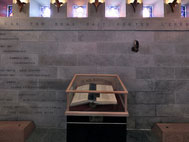Home to the Royal 22nd
The Québec Citadel has looked down from atop Cape Diamond for close to two centuries. Built by the British army to ward off an attack that ultimately never came, the fortress is typical of 17th century French fortifications and is known as the Gibraltar of the Americas. Today the Citadel is a working military base and home to the Royal 22nd Regiment, the only French-speaking regiment in the Canadian army.
An impregnable stronghold
The Citadel is the biggest of its kind in North America. Since 1831 it has stood atop Cape Diamond as a refuge of last resort for Québec City’s garrison, lest the city ever be taken by enemy forces. Its location and sheer size earned it the nickname “The Gibraltar of the Americas.”
The fort is made up of a star-shaped stone wall with four bastions. It surrounds a handful of buildings (barracks, hangars, armoury, powder magazine) designed to provide self-sufficiency in the event of a siege,. A hospital was even added in 1840. Two of its buildings date to the French regime: the Cap-aux-Diamants Redoubt, built in 1693, and the powder magazine, built in 1750.
Good things come to those...
Already in 1630 Champlain was talking about erecting a stronghold on Cape Diamond. One century later the king’s engineer, Chaussegros de Léry, also suggested building a citadel and drew up plans. But the project never got off the ground for lack of financial means.
Once in control of the town following the Conquest of 1759, the British reinforced French defences but still did not build a citadel. In 1775, however, after British troops were barely successful in fending off an American attack at the city gates, the authorities had a first citadel built from wood and earth at the top of Cape Diamond. It proved insufficient.
The long-awaited impetus
In 1812–1813 the Americans again tried—in vain—to invade the British colonies of Canada. That was enough to spur colonial leaders to build a permanent citadel of stone.
Engineer Elias Walker Durnford drew up the plans, taking inspiration from the work of renowned French engineer Sébastien Le Prestre de Vauban. Work lasted from 1820 to 1831. The result is the citadel that visitors see today.
Home to the Royal 22nd Regiment
In 1871 peace was sealed with the United States, and British troops left the city. The artillery school of the Canadian militia took up residence in the Citadel. Lord Dufferin, Governor General of Canada, made it his official residence and to this day it remains the governor general’s secondary residence after Rideau Hall in Ottawa.
The Royal 22nd Regiment made its home in the Citadel in 1920. The regiment was created on the eve of the First World War in 1914 to encourage French Canadians to enlist. It is the only infantry unit in Canada to be led in French and is proud to have fought in both world wars in Europe and in a number of subsequent conflicts.
A guardian of military heritage
The Royal 22nd Regiment is a guardian of this outstanding military heritage. Its troops pass on certain traditions, such as the changing of the guard in summer, when visitors come to see the regiment parade in full dress: a red tunic and heavy bearskin cap. Meanwhile inside the Citadel a museum displays the weapons, uniforms, and artefacts that bear witness to 300 years of military history in the city.
Related medias
Virtual tours

This memorial contains the Book of Remembrance recording the names of all the soldiers of the Royal 22nd Regiment killed in action since 1914. Every morning, a member of the military comes to the site and reads the names on one of the pages out loud.
Old pictures